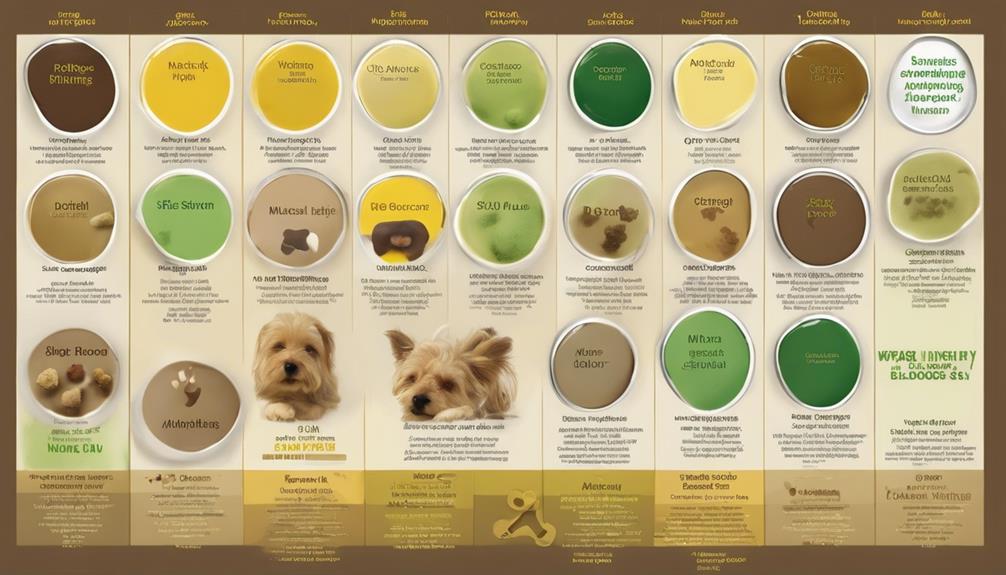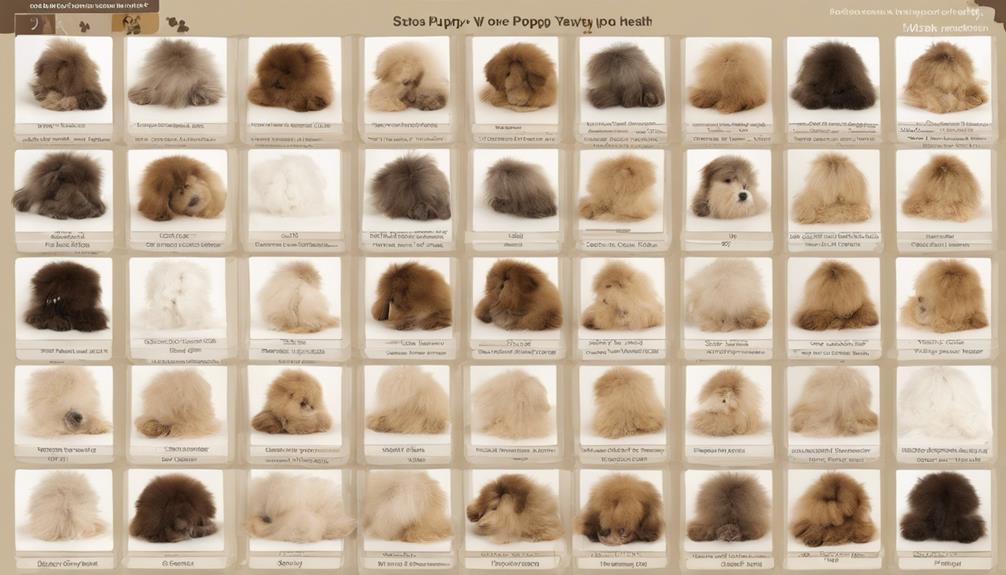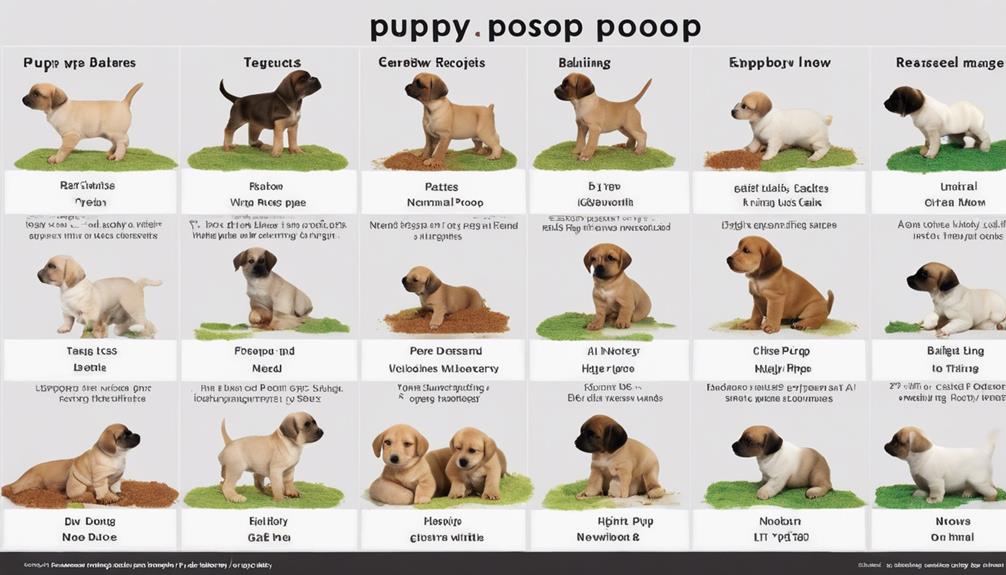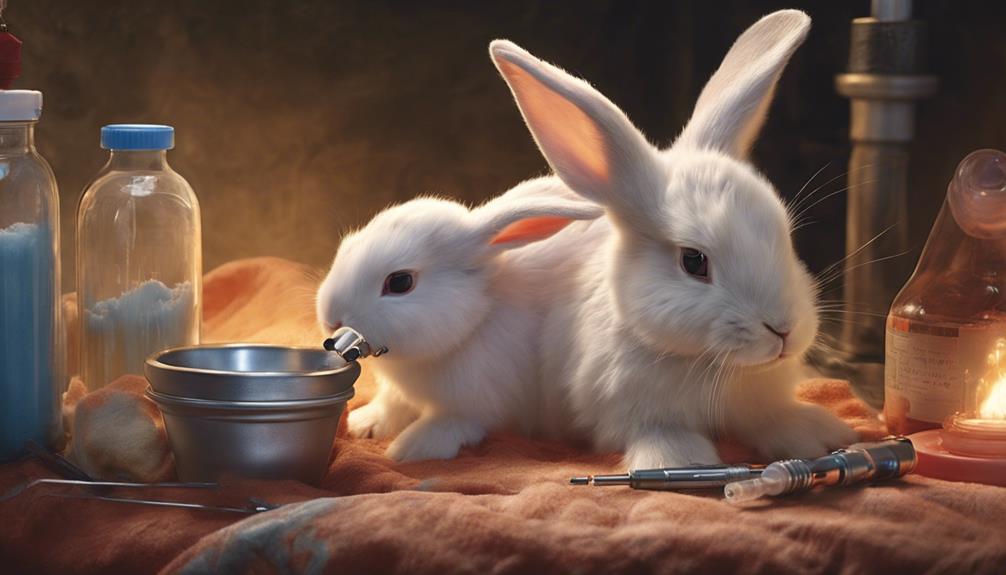As we navigate the world of newborn puppies, it's akin to deciphering a map with uncharted territories. Just as a compass guides us through unknown lands, a detailed guide for monitoring newborn puppy poop serves as our compass in understanding their health.
However, in this domain, every stool holds a tale waiting to be decoded. So, let's unravel the mysteries of puppy poop together, shedding light on the importance of this often-overlooked aspect of puppy care.
Key Takeaways
- Monitoring well-formed, orange poop indicates puppy health
- Abnormal colors, odors, or coatings signal potential health issues
- Consistent poop aids in early issue detection and overall well-being
- Seek immediate vet advice for white stools, weakness, or feeding changes
Normal Puppy Poop Characteristics
When appraising the health of newborn puppies, it's vital to understand the normal characteristics of their poop. Healthy puppy poop is typically well-formed, orange in color, and has a soft consistency. The color of the stool can vary slightly, but orange is a common and healthy hue. Additionally, one should be aware that the mother dog may consume the puppies' stools. This behavior is natural and aids in maintaining cleanliness and promoting good digestive health in the newborns.
Monitoring the consistency and color of newborn puppy poop is essential for detecting any potential digestive issues early on. Any sudden changes in stool color, such as a shift to red or black, may indicate underlying health concerns that warrant veterinary attention. By regularly observing and documenting the characteristics of the stool sample, pet owners can effectively track the health and development of their newborn puppies. Understanding what constitutes normal puppy poop is key to ensuring the well-being of these young animals.
Signs of Unhealthy Puppy Poop

Monitoring the characteristics of newborn puppy poop is important for identifying signs of digestive issues such as abnormal colors, consistency, and odors. Unhealthy puppy poop may present in colors like purple, green, or yellow-orange, indicating potential problems. Inconsistent consistency, unusual contents, and foul smells are also signs of unhealthy puppy poop that shouldn't be ignored.
If you notice a coating on the puppy poop, it may suggest large bowel irritation or even colitis. Additionally, unusually strong odors in the puppy poop can be a warning sign of impending diarrhea. These abnormal poop characteristics are concerning and should prompt you to consult a vet for proper evaluation and treatment.
Understanding Dog Poop Colors
Understanding the various colors of dog poop can provide valuable insights into your pet's health and well-being, helping you detect potential issues early on. Here are some key points to bear in mind:
- Brown: This is the normal color of healthy dog poop, indicating a balanced diet and proper digestion.
- Purple: A purple hue in your dog's stool may signal food-related issues or underlying concerns that warrant attention from a veterinarian.
- Green: Dog poop that's green can result from dietary factors or grass ingestion, but persistent green stools may require veterinary evaluation to rule out any underlying issues.
- Yellow-Orange: This color may indicate liver problems or indigestion in dogs. If you notice abnormal behavior accompanying this color of stool, it is crucial to consult your vet promptly for further evaluation.
Understanding these variations in poop color can help you keep an eye on your dog's digestive system health and promptly address any signs of illness by consulting your vet.
Importance of Consistency in Puppy Poop

Healthy puppy poop consistency serves as an important indicator of the digestive well-being and overall health of young dogs. Monitoring the consistency of a dog's poop is critical in identifying potential issues such as digestive health problems, dietary intolerances, or nutrient absorption issues early on. Maintaining a consistent poop consistency is essential for the proper digestion and overall well-being of newborn puppies. Changes in poop consistency can signal underlying health problems that require attention. Here is a table summarizing the key points related to the importance of consistency in puppy poop:
| Key Points | Details | Importance |
|---|---|---|
| Indicator of Health | Soft, yet formed poop indicates health | Early detection of issues |
| Digestive Well-being | Consistent poop aids digestion | Ensuring proper nutrient absorption |
| Monitoring for Problems | Changes indicate possible issues | Promoting overall well-being |
Regularly observing and analyzing your puppy's poop consistency is a simple yet effective way to keep track of their digestive health and overall wellness.
When to Seek Veterinary Advice
If you notice that your newborn puppy's poop is consistently white, it's imperative to seek veterinary advice promptly to address potential issues related to malabsorption or maldigestion.
Here are important signs indicating when to seek veterinary assistance for your newborn puppy:
- Immediate consultation is important for addressing symptoms like neonatal hypoglycemia, weakness, seizures, or abnormal behaviors after suckling.
- Changes in feeding habits, lethargy, or unusual vocalizations should prompt veterinary attention for newborn puppies.
- White stools in newborns can signal serious health concerns like septicemia, requiring prompt medical intervention.
- Managing dietary intake through bottle feeding and monitoring weight gain is essential for addressing white stools in newborn puppies.
Being vigilant about your puppy's poop color and associated symptoms can help in early identification of any health issues.
Prompt veterinary care plays an important role in ensuring the well-being of your newborn puppy.
Frequently Asked Questions
What Is the Normal Poop for a Newborn Puppy?
We focus on normal poop for newborn puppies, which is typically well-formed, soft, and orange. Monitoring such poop is important for evaluating health. Any abnormalities may indicate underlying issues needing vet attention. Consistency, color, and frequency are key indicators.
What Does Unhealthy Puppy Poop Look Like?
Unhealthy puppy poop can vary in color, consistency, and contents, suggesting health issues. Abnormal colors like red, black, or white, watery or hard stools, blood, mucus, or undigested food, coated appearance, and foul smell are red flags.
What Should 10 Week Old Puppy Poop Look Like?
At 10 weeks old, a puppy's poop should appear well-formed, brown, and have a firm texture resembling adult dog feces. Monitoring these characteristics aids in recognizing any health issues early on, ensuring peak development and vet care when needed.
How Do You Analyze Puppy Poop?
We assess puppy poop by observing color, shape, consistency, and any unusual elements. Changes can signal health issues. Monitoring frequency is key for digestive health evaluation. Keeping a poop chart aids in tracking patterns for necessary measures.
Conclusion
Just as the color and consistency of a newborn puppy's poop can reveal important insights about their health, it also serves as a symbol of their growth and development.
By closely monitoring their poop and seeking veterinary advice when necessary, pet parents can guarantee their little ones are on the right track towards a healthy and happy life.
Remember, a healthy pup starts from the inside out, so stay vigilant and proactive in caring for your furry companion.









